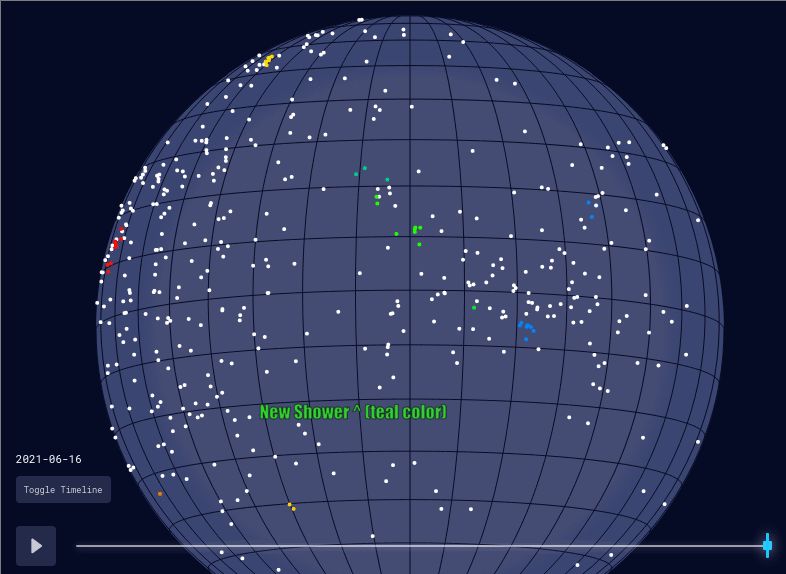Abstract: A new meteor shower from an eccentric sunskirting-comet orbit was detected by CAMS networks on June 9 to 14, 2021. Similar activity occurred last year but was not seen in prior years from 2010 to 2019. The geocentric radiant is located at R.A. = 304.4 deg, Decl. = –32.9 deg (equinox J2000.0), part of the JAQ#299 June Aquilid Complex. This new shower has been added to the IAU MDC working list of meteor showers as the June theta2 Sagittariids (JTT#1129).
1 Introduction
The southern-hemisphere networks of the CAMS video-based meteoroid orbit survey detected what appears to be a newly registered meteor shower from an eccentric sunskirting-comet orbit. During this time of year, the June Aquilid Complex (#295, JAQ) is active with a number of showers below the ecliptic plane leading up to the Southern June Aquilids (NZC#165) (Jenniskens, 2006).

Figure 1 – The June theta2 Sagittariids (JTT#1129), marked as the green cluster just below the ecliptic plane in the radiant-data visualization posted at the CAMS website for the dates 2021 June 10–13.
2 The observational results
The shower was detected in observations of the CAMS Namibia low-light video camera network (T. Hanke, E. Fahl, R. van Wyk), with additional detections by CAMS Australia (M. Towner, L. Toms, C. Redford), CAMS Chile (S. Heathcote, E. Jehin, T. Abbott), CAMS South Africa (T. Cooper, P. Mey), and CAMS New Zealand (J. Baggaley, I. Crumpton, N. Frost, C. Duncan).
Table 1 – Median orbital elements for the June theta2 Sagittariids (JTT#1129) (equinox J2000.0) obtained from CAMS data for 2021.
| 2021 | |
| λʘ (°) | 352.26 ± 0.05 |
| αg (°) | 304.4 |
| δg (°) | –32.9 |
| vg km/s | 36.9 |
| a a.u. | 1.05 ± 0.19 |
| q a.u. | 0.070 ± 0.008 |
| e | 0.932 ± 0.015 |
| ω (°) | 158.2 ± 0.8 |
| Ω (°) | 260.5 ± 1.1 |
| i (°) | 49.6 ± 5.9 |
| N | 52 |
2 Results
The shower was active between 2021 June 9 22h to June 14 01h UTC, corresponding to solar longitude 79.0° – 83.0° (equinox J2000.0). The shower is visible as a green cluster just below the ecliptic plane in the radiant maps of June 10 to June 14, 2021, at the data visualization website http://cams.seti.org/FDL/ . Median orbital elements from 52 triangulated orbits are listed in Table 1. The radiant is significantly dispersed in longitude, in a direction similar to the overall dispersion of the underlaying shower #165, but narrow in latitude. This shower is now called the June theta2 Sagittariids and was added to the IAU Working List of Meteor Showers as number 1129 (Jenniskens, 2021).
Similar activity was detected last year, from 2020 June 6 to 14, with a broad maximum on June 10 at solar longitude 79.7° (see http://cams.seti.org/FDL/ for those dates) but not in prior years from 2011 to 2019. It is possible that poor coverage in the southern hemisphere prior to 2020 contributed to that.
3 Discussion
From our lookup table, the CAMS data visualization mis-identified the shower as the radar-detected shower #765, the alpha Sagittariids (Pokorny et al., 2017). That shower, however, has a lower median speed and is very dispersed. The CMOR radar identified the activity as shower #165 at the website https://fireballs.ndc.nasa.gov/cmor-radiants/earth.html . Instead, this shower has a compact radiant off-center from that of the diffuse shower 165 and is only active for a few days.
The Northern June Aquilids have been linked to SOHO comet C/2009 U10 (Holman & Jenniskens, 2012). It is possible that the new shower is due to another comet fragment from a family of such fragments that resulted from the breakup of a common parent body some time ago and that have now dispersed by rotation of the nodal line.
References
D. Holman, P. Jenniskens (2012) Confirmation of the Northern Delta Aquariids (NDA, IAU #26) and the Northern June Aquilids (NZC, IAU #164). JIMO 40, 166–170
P. Jenniskens (2006) Meteor Showers and their Parent Comets. Cambridge University Press, p. 711.
P. Jenniskens (2021) June theta^2 Sagittariids 2021. CBET 4980, D. W. E. Green (ed.), Central Bureau for Astronomical Telegrams, issued 2021 June 19.
P. Pokorny, D. Janches, P. G. Brown, J. L. Hormaechea (2017) An orbital meteoroid stream survey using the Southern Argentina Agile MEteor Radar (SAAMER) based on a wavelet approach. Icarus 290, 162–182.




